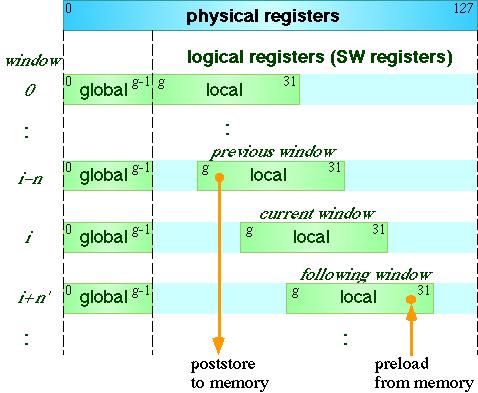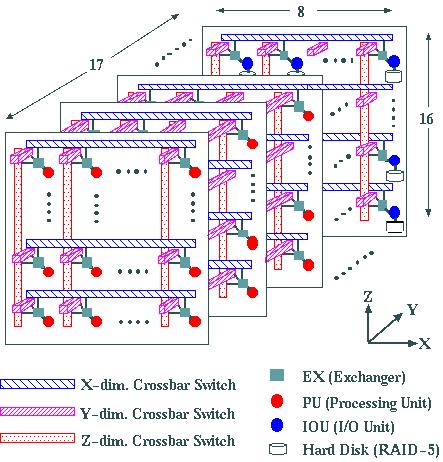
The CP-PACS is an MIMD (Multiple Instruction-streams Multiple Data-streams) parallel computer with a theoretical peak speed of 614Gflops and a distributed memory of 128Gbyte. The system consists of 2048 processing units (PU's) for parallel floating point processing and 128 I/O units (IOU's) for distributed input/output processing. These units are connected in an 8x17x16 three-dimensional array by a Hyper Crossbar network. A well-balanced performance of CPU, network and I/O devices supports the high capability of CP-PACS for massively parallel processing.
Each PU of the CP-PACS has a custom-made superscalar RISC processor with
an architecture based on PA-RISC 1.1. In large scale computations in scientific
and engineering applications on a RISC processor, the performance degradation
occuring when the data size exceeds the cache memory capacity is a serious problem.
For the processor of CP-PACS, an enhancement of the architecture called the PVP-SW
(Pseudo Vector Processor based on Slide Window)has been developed to
resolve this problem, while still maintaining upward compatibility with
the PA-RISC architecture.
The PVP-SW architecture has two elements. The Slide Window
Mechanism allows the use of a large number of physical registers through
a continuously sliding logical register window of 32 registers along the
physical registers. The Preload and Poststore
instructions, which can be issued without waiting for the completion
of memory access, allow a pipelined access to main memory, and thus a long
latency for memory access can be tolerated. With these features, an
efficient vector processing is realized in spite of the superscalar
architecture of the CP-PACS processor.

The Hyper Crossbar network of CP-PACS is made of crossbar
switches in the x, y, and z directions, connected together by an
Exchanger at each of the three-dimensional crossing points of the
crossbar array. Each exchanger is connected to a PU or IOU. Thus
any pattern of data transfer can be performed with the use of at most
three crossbar switches.
Since the network has a huge switching capacity
due to the large number of crossbar switches, the sustained data transfer
throughput in general applications is very high.
Data transfer on the network is made through Remote DMA (Remote
Direct Memory Access), in which processors exchange data
directly between their respective user
memories
with a minimum of intervention from
the operating system. This leads to a significant reduction in the startup
latency, and a high throughput.
The network allows a hardware bisection of PU arrays in each of
the x, y and z directions.
Hence the full system can be
divided up to 8 independent subsystems.
Hyper Crossbar network and distributed disk system

The distributed disk system of CP-PACS is connected to 128 IOU's on the 8x16 plane at the end of the y direction of the Hyper Crossbar network by a SCSI-II bus. RAID-5 disks are used for fault tolerance. The IOU's handle parallel file I/O requests issued by the PU's in an efficient and distributed way using Remote DMA through the Hyper Crossbar network.
The HIPPI connection to the front host is attached to one of the IOU's. A
special FTP protocol has been developed for a high speed file transfer
between the distributed disk system of CP-PACS and the disk storage of
the front host.